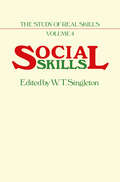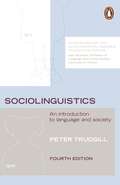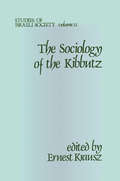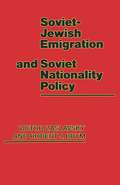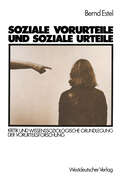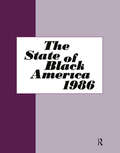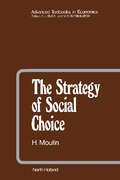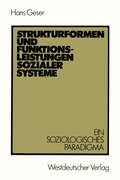- Table View
- List View
Social Conditions in Britain 1918-1939
by Stephen ConstantineOne popular image of the interwar years portrays the period as a time of depression, deprivation and decay. However, much recent work has tended to take, on balance, a more optimistic view of social conditions. In this pamphlet Dr Constantine examines the basis for such conclusions by reviewing the changing employment porspects for manual and non-manual workers, levels of family expenditure on food, consumer goods and leisure activities, the extent and causes of poverty, the quality of interwar housing and the records of the nation's health. The effects on living standards of demographic change, economic growth, wage levels and government policies are considered. The period is seen as a time of transition, witnessing significant shifts away from older patterns of employment and social conditions towards those characteristic of an affulent mass consumer society. However, there were casualties from this process of accelerated change, and class and regional inequalities remained.
Social Conditions in Britain 1918-1939
by Stephen ConstantineOne popular image of the interwar years portrays the period as a time of depression, deprivation and decay. However, much recent work has tended to take, on balance, a more optimistic view of social conditions. In this pamphlet Dr Constantine examines the basis for such conclusions by reviewing the changing employment porspects for manual and non-manual workers, levels of family expenditure on food, consumer goods and leisure activities, the extent and causes of poverty, the quality of interwar housing and the records of the nation's health. The effects on living standards of demographic change, economic growth, wage levels and government policies are considered. The period is seen as a time of transition, witnessing significant shifts away from older patterns of employment and social conditions towards those characteristic of an affulent mass consumer society. However, there were casualties from this process of accelerated change, and class and regional inequalities remained.
Social Institutions Of France
by Patricia Evans Roy Evans Pierre Laroque P. LaroqueFirst Published in 1983. Social problems have assumed a growing importance in France, as in all developed countries, especially since the end of the last century. While traditional early nineteenth century liberalism denied the existence of social problems as such, believing the greatest possible economic freedom to be the sole solution to all evils, the emphasis is still placed more and more insistently on the need for a definite and concerted welfare effort, to increase the material well-being of individuals and families. Since the second edition of this book was published in 1962, legislation and welfare services, and social reality itself have changed as much through circumstances as through political and economic evolution. It follows that the present edition of this book is, in fact, an almost wholly new book. It attempts to present a comprehensive view of French social life, drawing attention especially to welfare services and legislation as they are at the beginning of 1979.
Social Institutions Of France
by Patricia Evans Roy Evans Pierre Laroque P. LaroqueFirst Published in 1983. Social problems have assumed a growing importance in France, as in all developed countries, especially since the end of the last century. While traditional early nineteenth century liberalism denied the existence of social problems as such, believing the greatest possible economic freedom to be the sole solution to all evils, the emphasis is still placed more and more insistently on the need for a definite and concerted welfare effort, to increase the material well-being of individuals and families. Since the second edition of this book was published in 1962, legislation and welfare services, and social reality itself have changed as much through circumstances as through political and economic evolution. It follows that the present edition of this book is, in fact, an almost wholly new book. It attempts to present a comprehensive view of French social life, drawing attention especially to welfare services and legislation as they are at the beginning of 1979.
Social Organization: A Study of the Larger Mind
by Charles Horton CooleyThis classic text has set a standard for American sociol-ogy. Cooley provides analysis without empiricism, applying psychological insight to his study of the individual and collective self. First published in 1909, this work attempts to motivate man and society to be more responsible to each other.""The style of his book is clear and attractive, the text abounding in happy quotation.""--Annals of the American Academy of Political and Social Science
Social Organization: A Study of the Larger Mind
by Gary JensenThis classic text has set a standard for American sociol-ogy. Cooley provides analysis without empiricism, applying psychological insight to his study of the individual and collective self. First published in 1909, this work attempts to motivate man and society to be more responsible to each other.""The style of his book is clear and attractive, the text abounding in happy quotation.""--Annals of the American Academy of Political and Social Science
Social Skills
by W. T. Singletonw. T. SINGLETON THE CONCEPT This is the fourth in a series of books devoted to the study of real skills. A skilled person is one who achieves his objectives effectively, that is by an optimal expenditure of effort, attention and other resources working within his native capacities of strength, vision, intelligence, sensitivity and so forth. It is difficult if not impossible to measure in a quantitative sense. There is, however, no question about its presence or absence. The differences between a highly skilled performer and a mediocre one are so readily manifest that there is no ambiguity. The student of skill is a person interested in what these differences are and how they originate. The importance and the difficulty of skill study is that the concept is a universal one for human activity. The movement of one limb can be skilled or unskilled within the context of a task, so also can the way a leader addresses a large meeting of his followers. For these and other equally disparate activities there are certain descriptive terms which always seem to be applicable: continuity, sequencing, timing, together with a subtle combination of sensi tivity, adaptability and imperturbability. What happens at any instant is set precisely with the flow from what has already happened to what is going to happen. The order of events has a determinate logic which may not be obvious to the observer except with the benefit of hindsight.
Sociolinguistics: An Introduction to Language and Society (Pelican Ser.)
by Peter TrudgillThis is a classic book on a fascinating subject. Peter Trudgill examines the close link between language and society and the many factors that influence the way we speak. These range from gender, environment, age, race, class, region and politics. Trudgill's book surveys languages and societies from all over the world drawing on examples from Afrikaans to Yiddish. He has added a fascinating chapter on the development of a language as a result of a non-native speaker's use of it. Compelling and authoritative, this new edition of a bestselling book is set to redraw the boundaries of the study of sociolinguistics.
Sociology: An Introduction for Nurses, Midwives and Health Visitors
by Caroline CoxSociology: An Introduction for Nurses, Midwives, and Health Visitors focuses on the approaches, principles, and methodologies involved in sociology, including health care, patient care, social class, educational achievement, and kinship. The book first elaborates on health care from the classical era to the present, population structure and change, and family and kinship. Discussions focus on the family in a changing society, future of the family, population theory of Malthus, world population, developments in anatomy, physiology, and public health in Renaissance Europe, and origins in ancient Greece and Rome. The manuscript then examines social class and social stratification, education, religion, and secularization, and the provision of health care. Concerns include relationship between health care and health need, religion and total patient care, religion in contemporary society, social class and educational achievement, and social class and health. The text takes a look at the need for collaboration between nursing and sociology, sociological aspects of the care of the chronic sick, elderly, and the dying, and the sociological aspects of the care of the mentally ill, including challenges to the concept of mental illness, care of the chronic sick in institutions, and institutional care of the elderly. The manuscript is a dependable source of information for sociologists and researchers interested in sociology.
Sociology of the Kibbutz
by Ernest KrauszThis is the second volume of the publication series of the Israeli Sociological Society, whose object is to identify and clarify the major themes that occupy social research in Israel today. Studies of Israeli Society gathers together the best of Israeli social science investigation, which was previously scattered in a large variety of international jour-nals. Each book in the series is in-troduced by integrative essays.The contents of volume two focus on the sociology of a unique Israeli social institution—the kibbutz. Kib-butz society constitutes an impor-tant laboratory for the investigation of a variety of problems that have been of perennial concern to the social sciences. Topics in this volume include relevant contem-porary issues such as the dynamics of social stratification in a "classless" society, the function and status of the family in a revolutionary society, relations between generations, industrializa-tion in advanced rural communities, and collective economies versus the outside world. The questions of the concept and development of the kib-butz, social differentiation and socialization, and work and produc-tion within the kibbutz possess a significance far beyond their im-mediate social context. Does the kibbutz offer a model for an alter-native, communal lifestyle for the modern world? How has the kibbutz changed over the past decadeswithin the context of a rapidly modernizing Israeli society?Emphasizing the "nonfailure" of the kibbutz experiment and con-trasting it with many socialist, cooperative, and communal ex-periments that clearly did fail, Martin Buber, in his analysis, attributes this success to the kib-but/'s undogmatic character, its ability to adapt structures and in-stitutions to changing conditions, while preserving its essential values and ideals.This volume presents an excellent review of the social research under-taken on the kibbutz in the past decades, and provides an introduc-tion to the growing scientific literature on the kibbutz.Contributors: Melford E. Spiro, Menachem Rosner, Martin Buber, Joseph Ben-David, Daniel Katz, Naftali Golomb, Erik Cohen, Arye Fishman, Michael Saltman, S.N. Eisenstadt, Eva Rosenfeld, Amitai Etzioni, Ephraim Yuchtman, Eliezer Ben-Rafael, Nissim Cohen, Yonina Talmon-Garber, Joseph Shepher, Lionel Tiger, Edward C. Devereux, Reuben Kahane, Ivan Vallier, David Barkin, John W. Bennet, Yehuda Don, Uri Leviatan, Eliette Orchan, Shimon Shur and David Glanz.
Sociology of the Kibbutz
by ERNEST KRAUSZ; DAVID GLANZThis is the second volume of the publication series of the Israeli Sociological Society, whose object is to identify and clarify the major themes that occupy social research in Israel today. Studies of Israeli Society gathers together the best of Israeli social science investigation, which was previously scattered in a large variety of international jour-nals. Each book in the series is in-troduced by integrative essays.The contents of volume two focus on the sociology of a unique Israeli social institution—the kibbutz. Kib-butz society constitutes an impor-tant laboratory for the investigation of a variety of problems that have been of perennial concern to the social sciences. Topics in this volume include relevant contem-porary issues such as the dynamics of social stratification in a "classless" society, the function and status of the family in a revolutionary society, relations between generations, industrializa-tion in advanced rural communities, and collective economies versus the outside world. The questions of the concept and development of the kib-butz, social differentiation and socialization, and work and produc-tion within the kibbutz possess a significance far beyond their im-mediate social context. Does the kibbutz offer a model for an alter-native, communal lifestyle for the modern world? How has the kibbutz changed over the past decadeswithin the context of a rapidly modernizing Israeli society?Emphasizing the "nonfailure" of the kibbutz experiment and con-trasting it with many socialist, cooperative, and communal ex-periments that clearly did fail, Martin Buber, in his analysis, attributes this success to the kib-but/'s undogmatic character, its ability to adapt structures and in-stitutions to changing conditions, while preserving its essential values and ideals.This volume presents an excellent review of the social research under-taken on the kibbutz in the past decades, and provides an introduc-tion to the growing scientific literature on the kibbutz.Contributors: Melford E. Spiro, Menachem Rosner, Martin Buber, Joseph Ben-David, Daniel Katz, Naftali Golomb, Erik Cohen, Arye Fishman, Michael Saltman, S.N. Eisenstadt, Eva Rosenfeld, Amitai Etzioni, Ephraim Yuchtman, Eliezer Ben-Rafael, Nissim Cohen, Yonina Talmon-Garber, Joseph Shepher, Lionel Tiger, Edward C. Devereux, Reuben Kahane, Ivan Vallier, David Barkin, John W. Bennet, Yehuda Don, Uri Leviatan, Eliette Orchan, Shimon Shur and David Glanz.
Soziale Vorurteile und soziale Urteile: Kritik und wissenssoziologische Grundlegung der Vorurteilsforschung
by Bernd EstelSoziologie der Herrschaft: Analyse von Struktur, Entwicklung und Zustand von Herrschaftszusammenhängen (Studien zur Sozialwissenschaft)
by Hans HaferkampState of Black America - 1986
by Bernard E. Anderson John CalmoreFirst published in 1986. A collection of studies on Black America from 1985 to 1986 inclsuing the economic status, classes, political policies, housing, education and civil rights. Includes a population chart of American Blacks from 1980 to 1984.
State of Black America - 1986
by Bernard E. Anderson John CalmoreFirst published in 1986. A collection of studies on Black America from 1985 to 1986 inclsuing the economic status, classes, political policies, housing, education and civil rights. Includes a population chart of American Blacks from 1980 to 1984.
The Strategy of Social Choice (ISSN #Volume 18)
by H. MoulinAdvanced Textbooks in Economics, Volume 18: The Strategy of Social Choice focuses on the social, economics, and political implications of social choice. The publication first surveys introduction, social choice functions and correspondences, and monotonicity and the arrow theorem. Discussions focus on efficiency, anonymity and neutrality, classifying voting methods, normative versus positive approach to voting, voting and the non-strategic theory of social choice, and development of the strategic theory of voting. The text then ponders on strategy-proofness and monotonicity and sophisticated voting. Topics include sophisticated implementation, voting by binary choices, strategy-proof social choice functions and game forms, Gibbard-Satterthwaite theorem, and restricted domains. The manuscript examines cooperative voting and voting by veto, including the minority principle, proportional veto core, voting by integer veto, effectivity functions, maximal and stable effectivity functions, and implementation by Nash equilibrium. The text is a dependable source of data for researchers interested in the process of social choice.
Studies in Sociology: 9 Volume Set
by Various AuthorsThis 9-volume collection originally published between 1969 and 1983 contains a selection of subjects viewed through the perspective of sociology; including community; the family; friendship and kinship; leisure; women; and introductory statistics. This set will be a useful resource for those studying sociology as well as of interest for other social science courses.
Symbiosis in Parent-Offspring Interactions
by Leonard RosenblumAs part of the preparation of the materials for this volume, the contributors attended a conference designed to explore the basic concept of symbiosis and its applicability to the study of parents and their offspring. Each participant was asked to focus not on the parental behavior of various species, but on parent and offspring as a symbiotic unit. The presentations were informal and the discussions intense. The chapters that follow were written many months after the conference and reflect the authors' efforts to integrate the comments and criticisms of their colleagues. Out of this amalgam, the present volume was shaped. We wish to thank the National Institute of Mental Health for supporting the conference (Grant MH 36276) and the University of Chicago for hosting it. The editors would also like to acknowledge the contributions of Dr. M. Lewis and Dr. J. Reinisch, who provided additional perspectives on the discussions held at the meeting. Special thanks are due Gary Schwartz for his thoughtful assistance throughout the course of this project. Lu Ann Homza has provided invaluable secretarial help. Leonard A. Rosenblum Howard Moltz vii Contents 1. A Conceptual Framework for the Study of Parent-Young Symbiosis Howard Moltz and Leonard A. Rosenblum 2. Reciprocity and Resource Exchange: A Symbiotic Model of Parent-Offspring Relations 7 Jeffrey R. A lberts and David J. Gubemick 3. The Coordinate Roles of Mother and Young in Establishing and Maintaining Pheromonal Symbiosis in the Rat 45 Howard Moltz and Theresa M.
Tales from Chirgwin Hospital: Question of Management (Themes In Nursing Ser.)
by Courtenay C. Wade illus Audrey PrattTechnology And Social Change In Rural Areas: A Festschrift For Eugene A. Wilkening
by Gene F SummersThe possibility of nuclear war, the failure of the Green Revolution, the capabilities of genetic engineering, and other actual and potential effects of technological innovations have created demands for a more humane application of technology. Addressing this issue, Technology and Social Change in Rural Areas is a clear assessment of the current state of affairs. The book begins with a discussion of the changing paradigms of technology adoption and diffusion, the dynamics of public resistance, and the question of social responsibility in an age of synthetic biology. In subsequent sections, the contributors assess the revolutionary effect of technology on agriculture worldwide and conclude that radically new public policies are essential; expose the transformations of rural life and communities that result from the localized effects of technology and its use as a weapon in world-system politics; and critically examine the appropriate technology movement. The essays are presented to honor Professor Eugene A. Wilkening for his many pioneering and lasting contributions to the study of technology and rural social change. The book includes an intellectual biography of Professor Wilkening written by his long-time colleague and friend, William H. Sewell.
Technology And Social Change In Rural Areas: A Festschrift For Eugene A. Wilkening
by Gene F SummersThe possibility of nuclear war, the failure of the Green Revolution, the capabilities of genetic engineering, and other actual and potential effects of technological innovations have created demands for a more humane application of technology. Addressing this issue, Technology and Social Change in Rural Areas is a clear assessment of the current state of affairs. The book begins with a discussion of the changing paradigms of technology adoption and diffusion, the dynamics of public resistance, and the question of social responsibility in an age of synthetic biology. In subsequent sections, the contributors assess the revolutionary effect of technology on agriculture worldwide and conclude that radically new public policies are essential; expose the transformations of rural life and communities that result from the localized effects of technology and its use as a weapon in world-system politics; and critically examine the appropriate technology movement. The essays are presented to honor Professor Eugene A. Wilkening for his many pioneering and lasting contributions to the study of technology and rural social change. The book includes an intellectual biography of Professor Wilkening written by his long-time colleague and friend, William H. Sewell.
The Things They Say behind Your Back: Stereotypes and the Myths Behind Them
by William HelmreichIn this groundbreaking book in the dim world of opinion formation Helmreich opens a closet bursting with skeletons and explores the myths and historical roots of stereotypes pertaining to several ethnic groups: Are Jews really smarter? What about rhythmical Blacks, hard-drinking Irishmen, dumb Poles, emotional Hispanics, and all those cold, artificial WASPs sipping inevitable dry martinis? He discusses which stereotypes are false, which are true, how they originated, and why some of the most libeled groups promote warped perceptions about themselves.Helmreich has examined over four hundred scientific studies and combines hard facts with humor, anecdotes, and common sense in his courageous attempt to understand and explain stereotypes. He contends that we should discuss this topic openly and recognize the tendencies and traits, negative and positive,-that are rooted in a group's history and culture rather than pretend that there are no differences among the members of multiracial America.
The Things They Say behind Your Back: Stereotypes and the Myths Behind Them
by William HelmreichIn this groundbreaking book in the dim world of opinion formation Helmreich opens a closet bursting with skeletons and explores the myths and historical roots of stereotypes pertaining to several ethnic groups: Are Jews really smarter? What about rhythmical Blacks, hard-drinking Irishmen, dumb Poles, emotional Hispanics, and all those cold, artificial WASPs sipping inevitable dry martinis? He discusses which stereotypes are false, which are true, how they originated, and why some of the most libeled groups promote warped perceptions about themselves.Helmreich has examined over four hundred scientific studies and combines hard facts with humor, anecdotes, and common sense in his courageous attempt to understand and explain stereotypes. He contends that we should discuss this topic openly and recognize the tendencies and traits, negative and positive,-that are rooted in a group's history and culture rather than pretend that there are no differences among the members of multiracial America.



